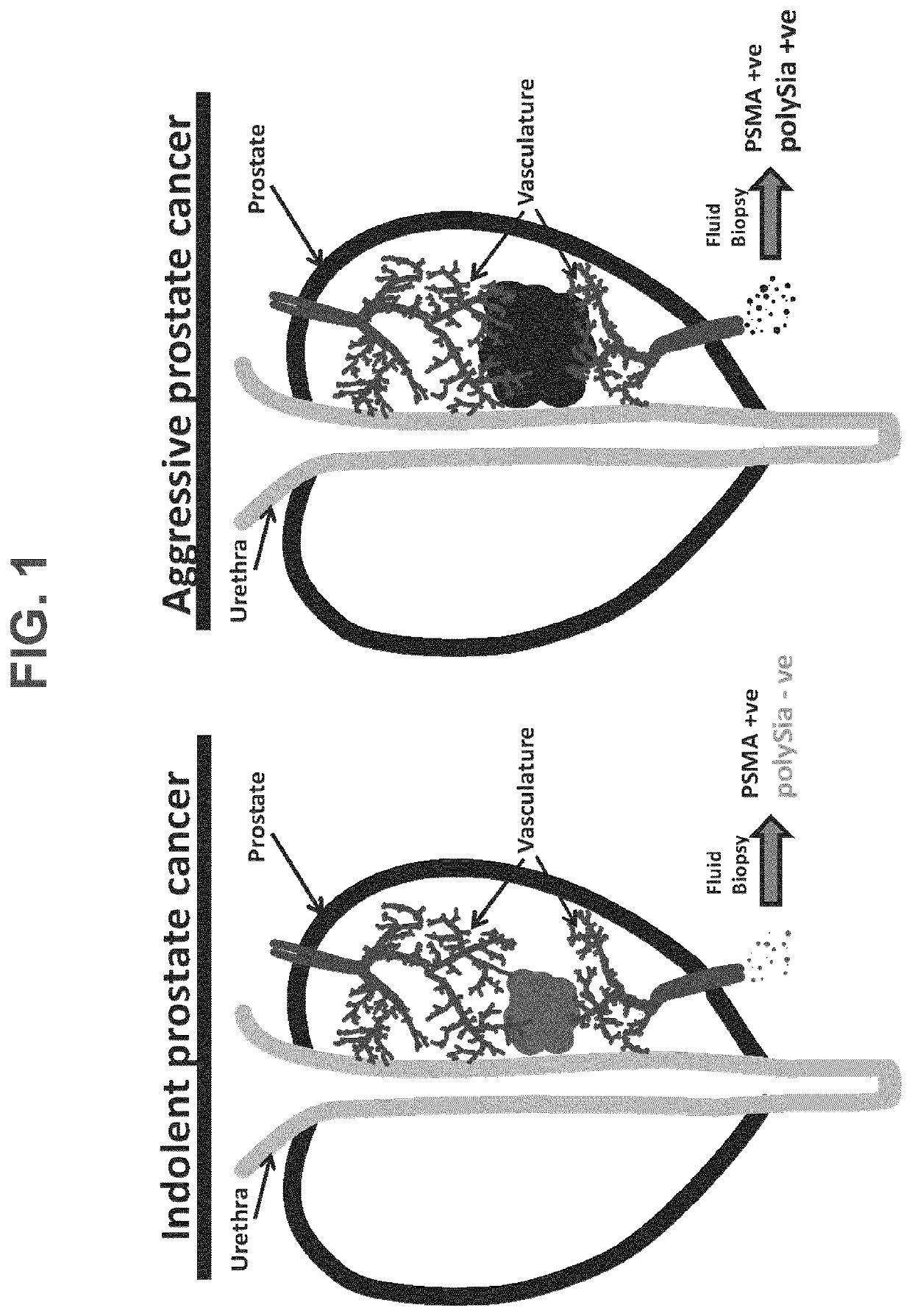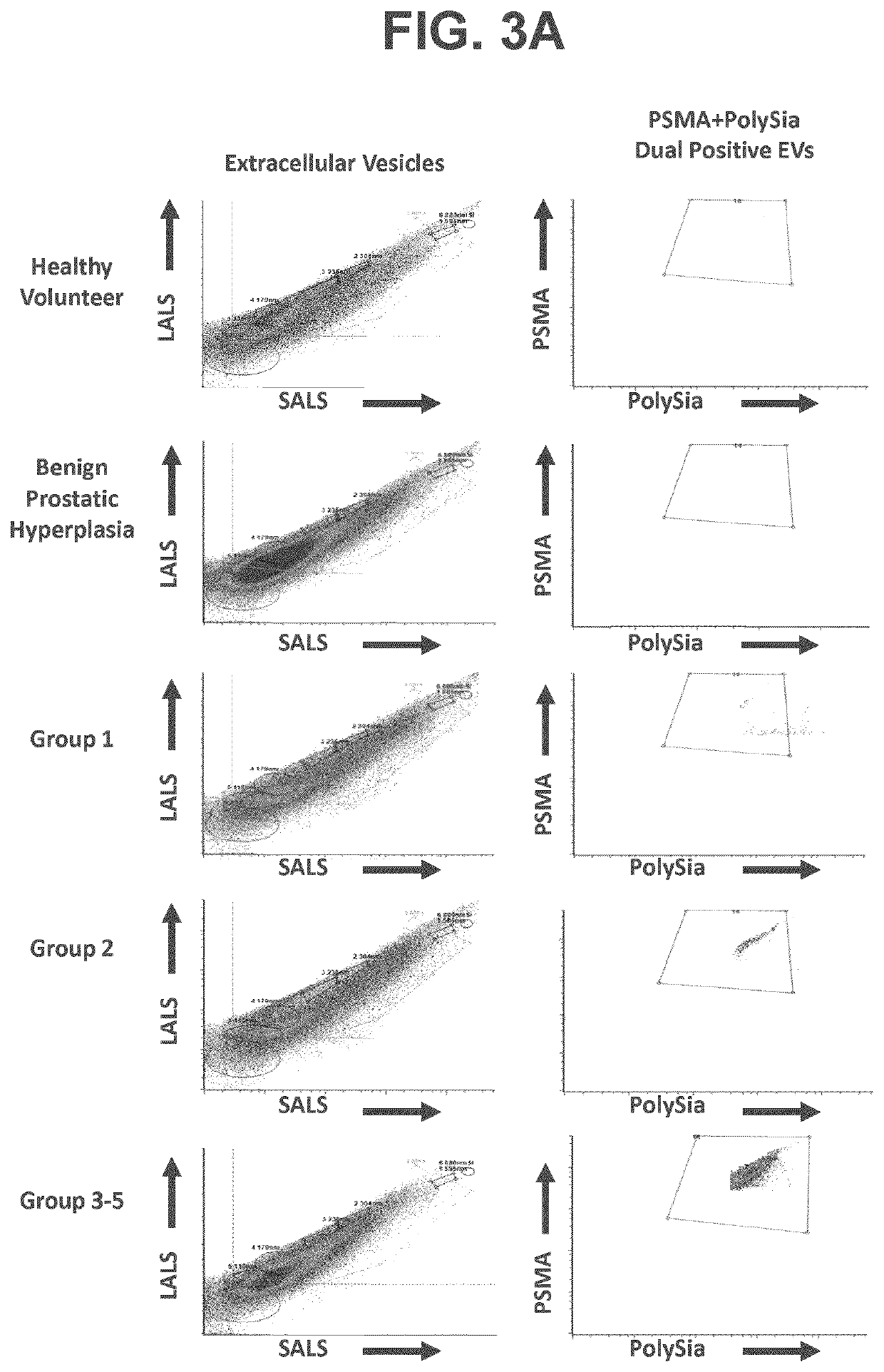Methods for diagnosing high-risk cancer using polysialic acid and one or more tissue-specific biomarkers
a cancer and polysialic acid technology, applied in the direction of biological material analysis, instruments, material analysis, etc., can solve the problems of preventing reducing the diagnostic accuracy of psa blood tests, and only killing cancer, so as to reduce the extent of disease, delay or slow the progress of disease, and prevent the spread of disease or condition
- Summary
- Abstract
- Description
- Claims
- Application Information
AI Technical Summary
Benefits of technology
Problems solved by technology
Method used
Image
Examples
example 1
Sia Dual-Positive Extracellular Vesicles Positively Correlate with Gleason Score
[0135]Plasma samples from 14 healthy controls, 20 benign prostate hyperplasia (BPH), and 81 patients with PCa, of which 28 are low-risk (GGS: 1), 29 intermediate-risk (GGS: 2), and 24 high-risk (GGS: 3-5) were immunostained with an antibody for the extracellular domain of prostate specific membrane antigen (PSMA) and a lectin-GFP fusion protein which binds polySia (GFP-EndoNDM). The endosialidase (EndoN) comes from an E. coli K1-specific bacteriophage and specifically hydrolyzes α2,8-linked polySia. The catalytically inactive enzyme, EndoNDM, serves as a lectin that binds polySia with a Kd of 10−8 M and has been used to detect polySia in cells. The population of PSMA-polySia dual-positive extracellular vesicles were found to positively correlate with Gleason Group score (GGS) (FIG. 1, FIGS. 3A-3B). Healthy controls and BPH patients exhibited the lowest number of dual positive PMP levels in plasma. Most i...
example 2
s Expressed in Prostate Cancer Cell Lines
[0136]The presence of polySia on PCa cell lines has not been reported. Expression of polySia on the PC3MLN4 human metastatic prostate cell line was found with anti-polySia IgG and fluorescence confocal microscopy (FIG. 2). PolySia exhibits a punctate distribution on the plasma membrane, which is in contrast to its more uniform distribution observed across the entire cell surface of neuronal cells, suggesting that different proteins may be polysialylated in PC3MLN4 cells. The localization of polySia to membrane protrusions and ruffles (FIG. 2, first and second row, respectively) in PC3MLN4 cells is intriguing as these are rich in lipid rafts and have important roles in cell signaling, potentially implicating polySia in a functional role in aggressive cancers. PC3MLN4 cells were also evaluated for their ability to produce polysialylated extracellular vesicles in vivo. Using an established avian embryo model, PC3MLN4 cells were pre-treated with ...
example 3
etrospective Analyses of Prostate Cancer Patient Plasmas
[0137]We can perform a fully powered retrospective analysis of randomized and de-identified patient plasmas to eliminate processing bias. To power a study in which the desired AUC curve (specificity vs. sensitivity) is 85% accurate across the Gleason score ≥8 patient cohort requires greater than 76 patients in each Gleason category, where 65 patients will be accurately identified in our assay for high-risk PCa. We anticipate an AUC 95% confidence interval of 0.79-0.96 under these conditions. In total, we will require 456 patient plasmas which can be obtained from ProCURE foundation, QC, which has all of these patient plasmas with at least 3 years of clinical follow-up for each sample. An additional cohort of patient plasmas collected at baseline prior to radical therapy (prostatectomy, radiation therapy, N≥76) from patients who exhibited early cancer recurrence (<3 years) can also be obtained from various cancer based bioreposi...
PUM
| Property | Measurement | Unit |
|---|---|---|
| size | aaaaa | aaaaa |
| size | aaaaa | aaaaa |
| diameter | aaaaa | aaaaa |
Abstract
Description
Claims
Application Information
 Login to View More
Login to View More - R&D
- Intellectual Property
- Life Sciences
- Materials
- Tech Scout
- Unparalleled Data Quality
- Higher Quality Content
- 60% Fewer Hallucinations
Browse by: Latest US Patents, China's latest patents, Technical Efficacy Thesaurus, Application Domain, Technology Topic, Popular Technical Reports.
© 2025 PatSnap. All rights reserved.Legal|Privacy policy|Modern Slavery Act Transparency Statement|Sitemap|About US| Contact US: help@patsnap.com



